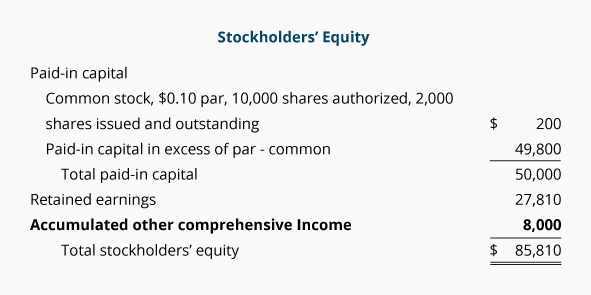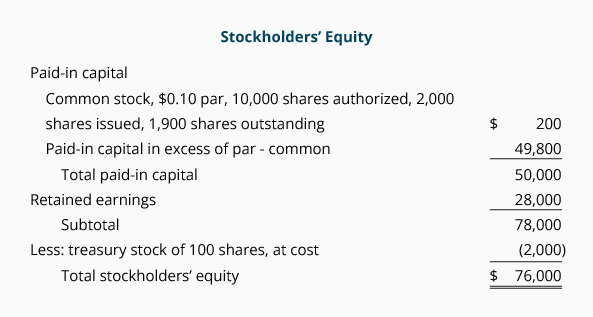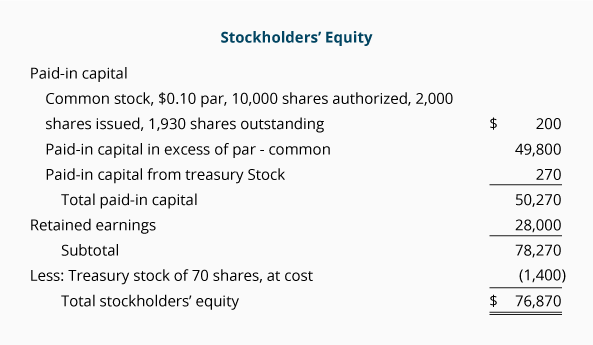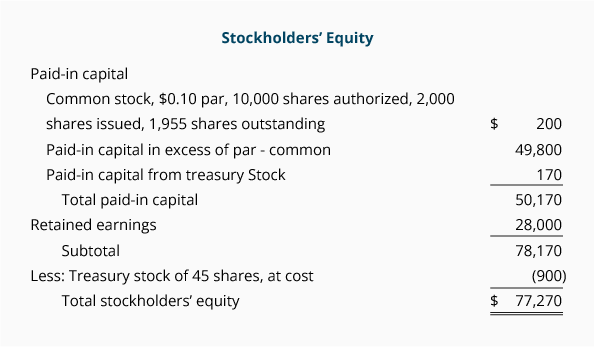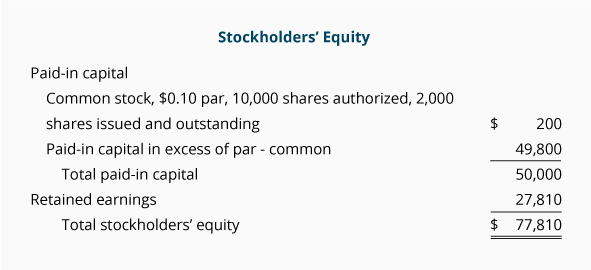Accumulated Other Comprehensive Income
Accumulated other comprehensive income refers to several items that were not included in net income and retained earnings. Examples include foreign currency translation adjustments and unrealized gains and losses on hedge/derivative financial instruments and postretirement benefit plans.
Below is an example of the reporting of accumulated other comprehensive income of $8,000. Notice that it is reported separately from retained earnings and separately from paid-in capital.
NOTE:
The net income reported on the corporation’s income statement is added to retained earnings.The other comprehensive income reported on the statement of comprehensive income is added to accumulated other comprehensive income.
Please let us know how we can improve this explanation
No ThanksTreasury Stock
A corporation may choose to purchase some of its outstanding shares of stock from its shareholders when it has a large amount of idle cash and, in the opinion of its directors, the market price of its stock is sufficiently low. If a corporation purchases a significant amount of its own stock, the corporation’s earnings per share may increase because there are fewer shares outstanding.
If a corporation purchases some of its stock and does not retire those shares, the shares are called treasury stock. Treasury stock reflects the difference between the number of shares issued and the number of shares outstanding. When a corporation holds treasury stock, a debit balance exists in the general ledger account Treasury Stock (a contra stockholders’ equity account). There are two methods of recording treasury stock: (1) the cost method, and (2) the par value method. We will illustrate the cost method. (The par value method is illustrated in intermediate accounting textbooks.)
Under the cost method, the amount the corporation paid to acquire the shares is debited to the account Treasury Stock. For example, if a corporation acquires 100 shares of its stock at $20 each, the following entry is made:
Stockholders’ equity will appear on the balance sheet as follows:
If the corporation were to sell some of its treasury stock, the cash received is debited to Cash, the cost of the shares sold is credited to the stockholders’ equity account Treasury Stock, and the difference goes to another stockholders’ equity account. Note that the difference does not go to an income statement account, as there can be no income statement recognition of gains or losses on treasury stock transactions. (This, of course, is reasonable since the corporation has the ultimate amount of inside information.)
If the corporation sells 30 of the 100 shares of its treasury stock for $29 per share, the entry will be:
Recall that the corporation’s cost to purchase those shares at an earlier date was $20 per share. The $20 per share times 30 shares equals the $600 that was credited above to Treasury Stock. This leaves a debit balance in the account Treasury Stock of $1,400 (70 shares at $20 each).
The difference of $9 per share ($29 of proceeds minus the $20 cost) times 30 shares was credited to the stockholders equity account, Paid-in Capital from Treasury Stock. Although the corporation is better off by $9 per share, the corporation cannot report this “gain” on its income statement. Instead the $270 goes directly to stockholders’ equity in the paid-in capital section as shown here:
If the corporation sells any of its treasury stock for less than its cost, the cash received is debited to Cash, the cost of the shares sold is credited to Treasury Stock, and the difference (“loss”) is debited to Paid-in Capital from Treasury Stock (so long as the balance in that account will not become a debit balance). If the “loss” is larger than the credit balance, part of the “loss” is recorded in Paid-in Capital from Treasury Stock (up to the amount of the credit balance) and the remainder is debited to Retained Earnings. To illustrate this rule, let’s look at several transactions where treasury stock is sold for less than cost.
We will continue with our example from above. Recall that the cost of the corporation’s treasury stock is $20 per share. The corporation now sells 25 shares of treasury stock for $16 per share and receives cash of $400. As mentioned previously, the $4 “loss” per share ($16 proceeds minus the $20 cost) cannot appear on the income statement. Instead the “loss” goes directly to the account Paid-in Capital from Treasury Stock (if the account’s credit balance is greater than the “loss” amount). Since the $270 credit balance in Paid-in Capital from Treasury Stock is greater than the $100 debit, the entire $100 is debited to that account:
After the 25 shares of treasury stock are sold, the balance in Treasury Stock becomes a debit of $900 (45 shares at their cost of $20 per share). The Paid-in Capital from Treasury Stock now shows a credit balance of $170.
The stockholders’ equity section of the balance sheet will now report the following:
Now let’s illustrate what happens when the next sale of treasury stock results in a “loss” and it exceeds the credit balance in Paid-in Capital from Treasury Stock. Let’s assume that the remaining 45 shares of treasury stock are sold by the corporation for $12 per share and the proceeds total $540. Since the cost of those treasury shares was $900 (45 shares at a cost of $20 each) there will be a “loss” of $360. This $360 is too large to be absorbed by the $170 credit balance in Paid-in Capital from Treasury Stock. As a result, the first $170 of the “loss” goes to Paid-in Capital from Treasury Stock and the remaining $190 ($360 minus $170) is debited to Retained Earnings as shown in this journal entry:
Again, no income statement account was involved with the sale of treasury stock, even though the shares were sold for less than their cost. The difference between the cost of the shares sold and their proceeds was debited to stockholders’ equity accounts. The debit was applied to Paid-in Capital from Treasury Stock for as much as that account’s credit balance. Any “loss” greater than the credit balance was debited to Retained Earnings. The stockholders’ equity section of the balance sheet now appears as follows:
Please let us know how we can improve this explanation
No Thanks

